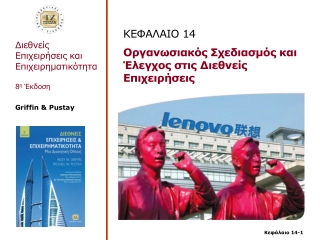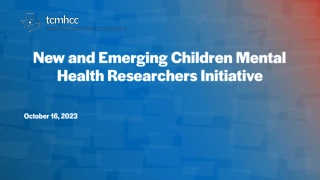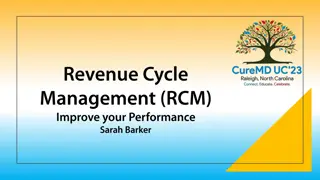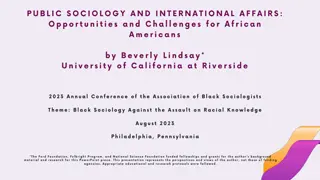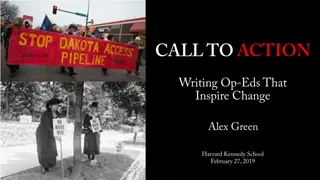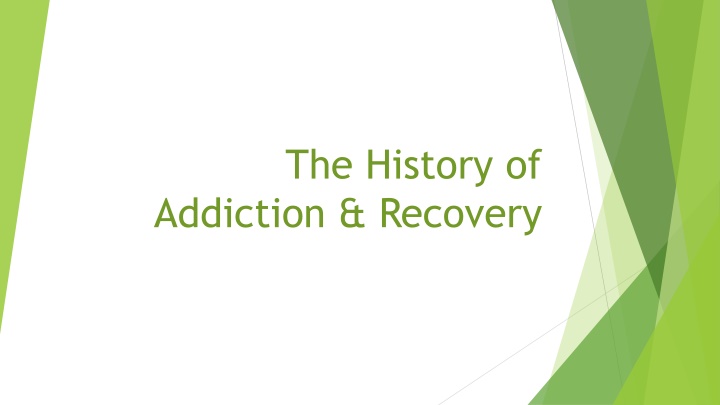
Evolution of Addiction Recovery Through the Ages
Explore the rich history of addiction and recovery from the 1700s to the modern-day, tracing significant events, influential figures, and societal changes. Uncover the progress in understanding and addressing addiction, culminating in awareness-raising events like the UNITE to Face Addiction Rally in 2015.
Download Presentation

Please find below an Image/Link to download the presentation.
The content on the website is provided AS IS for your information and personal use only. It may not be sold, licensed, or shared on other websites without obtaining consent from the author. If you encounter any issues during the download, it is possible that the publisher has removed the file from their server.
You are allowed to download the files provided on this website for personal or commercial use, subject to the condition that they are used lawfully. All files are the property of their respective owners.
The content on the website is provided AS IS for your information and personal use only. It may not be sold, licensed, or shared on other websites without obtaining consent from the author.
E N D
Presentation Transcript
The History of Addiction & Recovery
Objectives Recall the definition of recovery as developed by Substance Abuse Mental Health Services Administration s (SAMHSA); Discover who represents you in the state of Texas and nation; Recall 3 of the significant people discussed in this module; and Recognize 5 of the agencies mentioned in this module.
1700s This was during the Revolution period. This was a new country, not yet named The United States of America . 1704 The first regular newspaper was published in Boston. 1718 Pirate Blackbeard was killed off the coast of North Carolina. 1732 George Washington was born. 1772 Benjamin Franklin discovered electricity. 1790 The first state of the union, given by the first President George Washington. 1796 Tennessee is admitted to the Union.
1800s 1801 Thomas Jefferson was elected to his first term as President. 1803 Louisiana becomes part of the Union. 1804 The last northern state abolishes slavery. 1860 Abraham Lincoln ran for president with an anti-slavery campaign. He becomes president. This election split the nation. 1861 Seven southern states set up the Confederated States of America after seceding from the Union and the Civil War begins. 1865 The Civil War ends. President Lincoln is assassinated. Slavery is abolished. 1892 Ellis Island opens an Immigration Center.
1900s 1910 World War I began. 1930 The Great Depression occurred. 1941 Pearl Harbor was attacked and led American to enter into World War II. 1950 Most Americans owned a car. 1960 The time of Civil Rights. 1962 A conflict that later becomes a war, begins in Viet Nam. 1963 President John F. Kennedy is assassinated. 1980 The United States census reports the first population growth since the 1970 s. 1981 A woman becomes a Supreme Court Justice for the first time. 1991 America enters Operation Desert Storm.
2000s 40 years after Operation Understanding, a national event to bring awareness to recovery happened. The UNITE to Face Addiction Rally was celebrated October 4, 2015. This event filled the National Mall and could be heard for miles. There were more than 10,000 people in attendance.
Significant People Courtenay Baylor Benjamin Rush Anthony Benezet Bob Smith Michael Botticelli William Silkworth Betty Ford George Vaillant Harold Hughes Nora Volkow Carl Jung William White Patrick Kennedy Greg Williams Alexandre Laudet Bill Wilson Father Martin Cynthia Moreno Tuohy
Courtenay Baylor (1871 May 30, 1747) In the early 1900 s Baylor, himself a person in recovery, began working as the first addiction counselor on record. His recovery was his qualification for being a counselor. He had no formal training. He treated clients for alcoholism for $150.00 per month. Baylor claimed to have cured 65% of those under his care. Baylor would not treat a person who did not have motivation to change. Courtenay Baylor is said to have been the inspiration for one of the stories in the Big Book of Alcoholics Anonymous. Review the paper written by Courtenay Baylor, Remaking a Man: One Successful Method of Mental Refitting, from 1919.
Anthony Benezet (January 31, 1713 May 3, 1784) Born in France in 1713, Benezet moved to Philadelphia as a child. He became a teacher who advocated for equal educational rights for girls in 1755. Benezet was an abolitionist who opposed slavery and slave trade. He established and taught schools for black children in the 1760 s. Benezet was in favor of the Temperance Movement and was the author of The Mighty Destroyer 1774. This publication was the first essay written about alcoholism .
Michael Botticelli (January 2, 1958 Known as the Drug Czar, Michael Botticelli was director of the White House Office of National Drug Control Policy (ONDCP) during the Obama administration. Botticelli began his position in March 2014 and completed this position in January 2017. Botticelli, one of the leading addiction experts in the United States, was born in 1958 in Troy, New York. While in office Botticelli was open about being gay man who was in recovery from addiction. Currently, Botticelli is the Executive Director for the Grayken Center for Addiction at Boston Medical Center. Prior to his term with the White House he also worked in Boston as Director of Substance Abuse Services at the Massachusetts Department of Public Health.
Betty Ford (April 8, 1918 July 8, 2011) Agnew elected VP 1969 Agnew resigns October 10, 1973 Ford appointed VP December 6, 1973 Nixon resigns August 9, 1974 Ford becomes President December 6, 1973
Betty Ford was first lady of the United States, married to Gerald Ford. Gerald Ford became the acting President after the Nixon resignation. Betty Ford was born in Chicago, Illinois. A noted event in her life was the death of her father when she was 16 years old. Her father died of asphyxiation from carbon monoxide. Ford indicated there was not clarification if her the death of her father was suicide or accidental. Ford was married in 1942 to a traveling salesman, but the two divorced. In 1948 Betty and married two weeks prior to the election where Gerald Ford was elected as a United States Congressman. As First Lady, Betty Ford spearheaded equal rights for women, abortion, and divorce. She was a more outspoken First Lady than the previous. After President Ford s term in the White House ended, Mrs. Ford s drinking increased. Former President Ford and their daughter intervened and Mrs. Ford entered treatment on April 11, 1978 at the Long Beach Naval Hospital.
In 1978, when Betty Ford was 60-years old, she was candid and public about her admission to treatment for alcohol and prescription medication (MacPherson & Radcliffe, 1978). Following her treatment, Mrs. Ford realized there were no treatment centers to address the specific needs of women. She began raising funds to open a non-profit treatment center in Rancho Mirage, California. In 1982 The Betty Ford Center was opened. Mrs. Ford served on the Board of Directors until 2005. To this day, 50% of the center is dedicated to serving women (National First Ladies Library, n.d.). In 1983 the organization created a family program for children. Any child can attend the program, regardless of his or her ability to pay. The program was designed to teach children: Addiction is not their fault They are not alone There are healthy ways to cope with the pain and difficulties they face at home (Hazelden Betty Ford, 2018). To note her frank character, in 1997 Mrs. Ford was interviewed by Lesley Stahl for 60 Minutes. She began the interview by saying, Hello, I m an alcoholic and an addict (Stahl, 1997).
Of Interest History Channel show about Gerald Ford. History Channel show about Richard Nixon. History Channel information about Spiro Agnew.
Harold Hughes (February 10, 1922 October 23, 1996) Harold Hughes joined the United States Army in 1942 and served in combat during World War II. He was medically discharged from the Army in July 1945 due to contracting malaria while in service. The impact of the war is likely the reason for Hughes heavy drinking and suicide attempt after his discharge. In 1954 Harold Hughes began recovery from Alcohol Use Disorder. He used AA as his pathway to recovery. Hughes drove a semi, which led him to serve as the Iowa State Commerce Commissioner from 1959 1962. Hughes was the 36thGovernor of Iowa from 1960 1969. He was also a United States Senator for Iowa from 1969 1975.
While serving in the United States Senate, Hughes authored the Comprehensive Alcohol Abuse and Alcoholism Prevention, Treatment, and Rehabilitation Act of 1970 (Porter, 2011) now called the Hughes Act. This piece of legislation established the National Institute on Alcohol Abuse and Alcoholism (NIAAA), part of the National Institute of Health (NIH). While in the Senate, Hughes also convinced a military committee to offer substance use treatment to active duty military members and sponsored legislation preventing employers from discriminating against a person seeking treatment for substances. In 1979 Hughes wrote about his alcohol use disorder with author Dick Schneider. The book is called Harold E. Hughes: The Man from Ida Grove. Review the 1997 Journal Interview from Addiction, Conversation with Senator Harold Hughes.
Carl Jung (July 26, 1875 June 6, 1961) Carl Jung was born in Switzerland and is the founder of Analytic Psychology. Early in his career, Jung worked at the Asylum at the University of Zurich. Jung worked with Sigmund Freud and was thought of as Freud s successor, but, Jung did not agree with all of Freud s work. One of Jung s more notable pieces of work was his division of people into two types: Introverts and Extroverts. He is also the psychologist attributed with developing the theory related to the Collective Unconscious and the theory of Archetypes (The Editors of Encyclopedia Britannica, 1998).
Jungs contribution to addiction and recovery began when Jung treated a man name Roland Hazzard in the 1930 s. Hazzard suffered from Alcohol Use Disorder. Jung explained to Hazzard the importance of what Alcoholics Anonymous calls a vital spiritual experience (1976, p. 26). When Hazzard returned to the United States after being treated by Carl Jung in Switzerland, he began attending the Oxford Groups. Jung understood alcohol not only changed the way a person felt but alcohol could also mask distress (Addenbrooke, n.d.). A great deal of Jung s work was related to dreams and not addiction specific, yet, interesting, nonetheless.
Patrick Kennedy (July 14, 1967 From 1995 2001, Patrick Kennedy represented Rhode Island as a Congressman. Patrick was an advocate for decreasing stigma against mental illness and Substance Use Disorder. One of the more notable of his accomplishments was co-authoring and pushing through the Mental Health Parity and Addiction Equity Act. Kennedy, a democrat, co-authored this bill with Jim Ramstad, a republican. Mental Health Parity and Addiction Equity Act requires insurance to cover brain disorders, such as mental illness and Substance Use Disorder, in the same way as all other medical issues. Read the provisions in the Parity Act.
Patrick is the son of Ted Kennedy, the well-known brother of the assassinated US President John F. Kennedy. Most believed Patrick would spend his life in politics, as so many of his family members did. However, following the death of his father, Patrick announced his intention not to run for office again. Patrick was five years into his own, very public, recovery from substance use disorder and mental illness. You can watch his conversation with Lesley Stahl, in a 60 Minutes interview, discussing the reason he would not run for office again. Since leaving office in 2001, Patrick has become one of the foremost advocates on mental health. Visit his website to gain insight into his agenda. Jim Ramstad is a Congressman who represented Minnesota from 1991 2009. Ramstad was also public about his recovery.
Alexandre Laudet Dr. Laudet is internationally known. She conducts research on addiction and recovery. She is one of the first to research the impact of Collegiate Recovery programs on college and university campuses. Dr. Laudet is the founder and Director of the Center for the Study of Addictions and Recovery at the National Development and Research Institutes, Inc. (NDRI) and speaks internationally. Her research is peer reviewed and she serves as Associate Editor for two scientific journals. Review the Life in Recovery report on survey findings prepared for FAVOR by Laudet.
Father Martin (October 12, 1924 March 9, 2009) Born in Baltimore, Maryland, Joseph Martin was a Catholic priest, in recovery from alcohol use disorder, and was a world renowned speaker. Most people who were in treatment in the 1970 s 1990 s likely saw at least one of his videos. His charismatic and captivating personality provided him an ability to educate people with addiction and their families in a way many others were unable. Father Martin is definitely one of the pioneers in the addiction and recovery field. He was one of the most vocal, and loveable, advocates decreasing stigma of his time.
Father Martin founded Kelly Productions, a film production company, in 1972. In 1983 Father Martin and his friend Mae Abraham founded a treatment center called Ashley. Ashley is located in on the Chesapeake Bay in Northern Maryland. Today Ashley offers: Medication Assisted Treatment: Psychological and Psychiatric Care: Clinical Care: Holistic Care; and Gender specific programs.
Chalk Talk a clip
Benjamin Rush (January 4, 1746 April 19, 1813) Benjamin Rush was one of the signers of the United States Declaration of Independence. He was a graduate of Princeton University, The University of Edinburgh, and West Nottingham Academy. Rush was a medical doctor, politician, and educator. He founded Dickinson College in Carlisle, Pennsylvania in 1783 and Franklin College in Lancaster, Pennsylvania in 1787. Rush wrote prolifically about the dangers of and campaigned against hard drinking. You can view a NIH journal article written by B.S. Katcher, Benjamin Rush s educational campaign against hard drinking. This article also provides access to the volumes Rush wrote on the subject. One of the many books her wrote was Medical Inquiries and Observations upon the Diseases of the Mind.
Bob Smith (August 8, 1879 November 16, 1950) Dr. Bob Smith was born in St. Johnsbury, Vermont and graduated from Dartmouth College in 1902. Dr. Bob was a successful surgeon in Akron, Ohio who struggled with alcohol use. Dr. Bob began his recovery on June 10, 1935 after becoming close friends with Bill Wilson. Dr. Bob and Bill Wilson co-founded Alcoholics Anonymous (AA). After achieving his own recovery, Dr. Bob visited St. Thomas Hospital daily to meet with patients who were struggling with alcohol use. Dr. Bob believed service to be one of the fundamental elements of recovery. Dr. Bob was sober 15-years when he passed away in Akron on November 16, 1950.
William Silkworth (1873 1951) William Silkworth, M.D. was a Princeton educated medical doctor who spent much of his career working with men who were admitted to the hospital for alcohol use. According to extensive records kept by Alcoholics Anonymous, Dr. Silkworth was called the little doctor who loved drunks (O., 1998). William Silkworth s contribution to Alcoholics Anonymous was enormous. Silkworth and Bill Wilson met while Bill was in treatment at Town s Hospital in Akron, Ohio in 1933. Silkworth explained to Bill that Alcohol Use Disorder was not simply a moral defect or bad behavior. Silkworth explained his theory of AUD being a disease. Silkworth s explanation would find its way into the Big Book of Alcoholics Anonymous and be the only contribution to this day by a non-member.
The Disease Concept explains the difference between a person with AUD and a person without occurs in the brain. The brain of a person with AUD is changed when alcohol is ingested. Dr. Silkworth determined this through the consistencies in his patients being treated. Today, NIH and other organizations have furthered the proof of this concept through study of the brains of people with AUD living and dead. PET scans and MRI s can provide insight into the changes that occur in the brain of a person with AUD that do not occur in a person without.
George Vaillant (1934 Dr. Vaillant is a psychiatrist and professor at Harvard Medical School. Perhaps, his interest in psychiatry was personal. His father committed suicide when Dr. Vaillant was only 11-years old. Dr. Vaillant graduated from Harvard, completed hi residency in Massachusetts, trained in Boston and is a now a fellow at the Center for Advanced Study in the Behavioral . Dr. Vaillant is included in this list of significant contributors to the addiction and recovery profession due to the ground-breaking study he began in 1938. Vaillant has followed 200 men from when they were undergraduate college students. He is still following those that are alive and into their 90 s. This long-term study provided information about the use of alcohol. This study provided information about the abuse of alcohol being the biggest indicator of interference to happiness and health compared to all of the other major life events studied.
Nora Volkow (Mar 27, 1956 Dr. Volkow was born in Mexico. Volkow received a medical degree from the National University of Mexico in Mexico City. Dr. Volkow here she received an award for best medical student of her generation. During her residency she was given an award as one of the 10 Outstanding Psychiatric Residents in the USA. Dr. Volkow became the Director of the National Institute on Drug Abuse (NIDA) at the National Institutes of Health in May 2003. Her work has contributed education about addiction being a brain-based disorder. A prolific writer, Dr. Volkow has published over 680 articles and more than 100 book chapters and manuscripts for mental health and addiction (National Institute on Drug Abuse, 2017).
View Dr. Volkow on 60 Minutes speaking about addiction A Ted Talk, How Our Brains Get Addicted.
William White William Bill L. White was introduced in the Defining Recovery module. The history of addiction and recovery are intertwined and it becomes complex to separate them from one another. Highlights explored in this module are available through William White in greater depth. William White has been in the addiction field since 1969. He has held various positions, has conducted a considerable amount of research about addiction and recovery. His work available on his website.
Greg Williams Filmmaker Greg Williams began his recovery from substances when he was 17- years old. He became an outspoken advocate. Williams is also of 4thDimensions, LLC since 2014. At 31-years old, Williams created the film, The Anonymous People. The Anonymous People Williams is a co-founder of Facing Addiction, an organization which launched at the Unite to Face Addiction rally in Washington, DC, of which Williams was an integral part. Facing Addiction recently merged with the National Council on Alcoholism and Drug Dependence (NCADD). The second notable film Williams produced related to recovery was Generation Found. Generation Found is based on the largest recovery high school in the United States, which is located in Houston, Texas.
Bill Wilson (November 26, 1895 - January 24, 1971) Bill Wilson said he had his first drink of alcohol in the Army during World War I and soon began drinking heavily. In 1918 married Lois Burnham. Wilson had a successful career as a stockbroker until the stock market crash of 1929. Shortly after the stock market crash Bill began to drink more and drink most of the day. He and his wife moved into the basement of his wife s parent s basement. In 1934 Bill was visited by a friend, Ebby Thatcher. Ebby and Bill were childhood friends. Ebby had been befriended by Roland Hazzard who was a patient of Carl Jung. Ebby was a member of the Oxford Groups. He shared about his recovery with Bill.
Soon after Ebbys visit, Bill entered treatment at Town Hospital. This is where Bill met Dr. Silkworth. Following treatment, Bill often visited the hospital to help others. While on a business trip, Bill was tempted to drink in the bar of the Mayflower Hotel. Instead, he made phone calls to local churches to lend help to others who might have alcohol problems. This is how he met Dr. Bob Smith. Dr. Bob Smith and Bill Wilson, both in recovery, co-founded Alcoholic Anonymous.
Cynthia Moreno Tuohy Cynthia Moreno Tuohy, BSW, NCAC II, is currently the executive director of NAADAC, the Association for Addiction Professionals. Moreno Tuohy has rich career experience and personal recovery that empowers her to lead others in federal advocacy for addiction and recovery. Mrs. Moreno Tuohy led the national project group creating the Recovery to Practice (RTP) curriculum. She was also an advisor to UNT s Recovery to Practice.
References Found in lecture portion of module.

